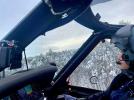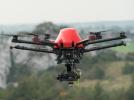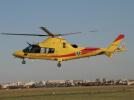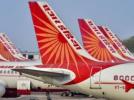Ryanair B738 at Faro on Oct 24th 2011, control difficulties
A Ryanair Boeing 737-800, registration EI-DPA performing flight FR-7417 from Faro (Portugal) to Paris Beauvais (France) with 145 passengers and 6 crew, was climbing out of Faro with the first officer (24, ATPL, 2,815 hours total, 2,610 hours on type) being pilot flying and the captain (29, ATPL, 4,366 hours total, 4,088 hours on type) being pilot monitoring, when the first officer after becoming airborne noticed the aircraft wanted to roll right and needed full left aileron to keep the wings level. He trimmed the rudder to ease keeping wings level but not enough to engage the autopilot until the aircraft had reached safe height. The commander decided to not accelerate beyond 220 KIAS, level off at FL120 and remain in the vicinity of the aerodrome to sort the issue out, the first officer subsequently trimmed the rudder to permit the autopilot to engage while the crew referenced the related checklists to restricted or jammed flight controls neither of which seemed to apply as the controls appeared free and unrestricted but seriously out of trim. The crew decided to return to Faro and applied normal landing configuration including flaps at 30 degrees and landed safely on Faro's runway 28 about 28 minutes after departure.
The Irish Air Accident Investigation Unit (AAIU) released their final report into the serious incident concluding the probable causes of the serious incident were:
Probable Cause
Undetected structural damage caused to the rudder system of EI-DPA by violent wind gusts associated with a microburst, while the aircraft was parked.
Contributory Causes
- The speed of the wind gusts at LPFR considerably exceeded the figure of 65 kts specified in FAR 25.415 Amendment 25-91.
- The absence of a requirement in the AMM to comprehensively check the flight control systems of an aircraft which has been subjected to an extreme meteorological event.
The AAIU reported that the aircraft had been parked at Faro aerodrome over night. A storm cell associated with microbursts went over the aerodrome, wind speeds of of up to 84.9 knots were recorded at the aerodrome. The aircraft as result jumped its chocks, the nose gear moved left 5 meters. Maintenance inspected the aircraft but could not see any damage and did not find any anomaly during subsequent ramp inspection.
The crew did not notice any anomaly during the walk around, subsequently performed the flight control checks as per the various checklists showing the controls were free and unrestricted and appeared to be working normally.
During acceleration for takeoff the aircraft handled normally, only immediately after the aircraft became airborne the aircraft had a strong tendency to roll right requiring full left aileron deflection to counter the roll.
The first officer applied just some left rudder trim initially to ease control of the aircraft but not enough to be able to engage the autopilot while the aircraft continued to climb to safe height, while working the related checklists, all found unsuitable and the crew finally concluding there was no matching checklist available, the first officer applied about 8 points of left rudder trim (an engine failure would require 5 points of rudder time) and was able to engage the autopilot afterwards.
The captain said in post flight interviews: "Once the aircraft had been trimmed it flew normally with the autopilot engaged. However we knew that an engine failure would require about five units of rudder trim and we had eight. We knew there had been high winds the night before which may have caused damage. Weather was good in Faro and it was an engineering base so we made the decision to return."
The commander decided to have the first officer continue to fly the aircraft to the landing knowing his abilities.
The captain wrote in the log book: "Flight control check in before taxi checks normal. Normal taxi. At low speed t/o normal. As we accelerated past about 100 kts the amount of right (sic) rudder required to keep the aircraft straight increased significantly (wind only 300/15, runway 28). On rotation a large left aileron deflection required to keep the aircraft from banking. Rudder trim applied to minimise the bank and engage the autopilot. Approx 8 units of left rudder trim required. Returned to Faro. Normal landing."
The AAIU reported that maintenance removed panels from the vertical stabilizer in order to access the rudder power control units (PCU) and found the support brackets for both PCUs had sustained damage like cracking, fracturing and displacement and involved the aircraft manufacturer. The AAIU reported: "The Manufacturer’s team carried out their examination of EI-DPA between November 16 and 18, 2011. When they removed panels from both sides of the vertical stabiliser, they found remnants of sheared fasteners together with broken pieces of the anti-rotational bushings from both rudder PCUs at the bottom of the bay containing the PCUs. These items were removed and packaged to be sent for laboratory examination."
The rudder was found to move freely but with more travel to the right than to the left.
At the tailstock of the standby PCU the upper and lower flanges attached to the support bracket securing the forward part of the PCU were found cracked (see image below). At the tailstock of the main PCU four fasteners securing the left hand support bracket were found sheared, the right hand fasteners had remained intact but the bracket was deformed.
Further examination revealed several hinge points of the rudder were damaged. The AAIU stated: "This damage exhibited evidence that the rudder had over-travelled with the trailing edge moving to the right. The skin of the rudder leading edge had come into contact with the hinge mechanism structure, which perforated the rudder skin leaving impact marks on the hinge mechanism. The GPIAA Investigator who oversaw the inspection stated that the damage in the area of the hinges could not be seen when the blade seals were in place, and in particular was not visible from the ground during what he termed a “normal inspection.” He also reported that the hinges and balance panels were found to be in good condition."
In addition the nose gear actuators were found leaking hydraulic fluid, which had not been noticed prior to the wind event.
Both PCUs were removed from the aircraft and sent for laboratory examination. The PCUs, the vertical stabilizer and the rudder were replaced. The damaged structural parts were also shipped for laboratory analysis.
The AAIU analysed that the two wind sensors at threshold runway 10 and threshold runway 28 showed significantly different winds illustrating the narrow and concentrated nature of the most intense part of the microburst, which had left a path of destruction of 3km in length and not more than 500 meters in width between the western part of the aerodrome and the city of Faro. The aircraft experienced high winds attacking the vertical tail and rudder from the left and slamming the rudder to the right against its mechanical limits, consistent with the damage exhibited. The windspeed of 85 knots exceeded the certification requirements that aircraft should be able to withstand wind speeds of 65 knots while on the ground and those effects onto control surfaces. The AAIU analysed: "In the subject case, it is likely that the aircraft and specifically the rudder surface and control system, was subjected to excessive loads due to ground wind speeds considerably greater than 65 kts."
The AAIU analysed: "The initial effect of the trailing edge of the rudder being displaced to the right would have been a tendency for the aircraft tail to move to the left as the aircraft accelerated along the runway during its take-off roll. This was due to the altered shape of the vertical stabiliser/rudder aerofoil section, creating a lateral aerodynamic force to the left on the stabiliser. Rudder effectiveness increased with airspeed so as the aircraft accelerated along the runway, this lateral force increased.
This would have manifested itself to the Flight Crew as a tendency for the aircraft to drift to the right, which became more accentuated as the speed increased. The data shows that there was an increasing left rudder pedal input as the aircraft accelerated, which centralised the rudder and kept the aircraft straight along the runway.
As the aircraft became airborne, the rudder pedal position moved back towards 0° with the rudder itself again moving to the right. This rudder pedal movement is consistent with the normal centralisation of flight controls after take-off. The data shows an immediate and very significant input of left control wheel, with recorded values up to 65°. The PF required this opposite control wheel input to maintain the aircraft wings approximately level, in order to compensate for the roll to the right, which is the secondary effect of the rudder deflection to the right."
The AAIU commended the crew: "Given the situation in which they found themselves once the aircraft became airborne, the issues were operationally well handled by the Flight Crew. They used the Operator’s decision making tool to analyse the problems and to make the prudent decision to return to LPFR, which as their home base was familiar to them and also where they knew the weather to be good."
The fasteners at the main PCU (Photo: AAIU):
The cracked flange at the standby PCU (Photo: AAIU):
http://avherald.com/h?article=478cbf93














Komentarze